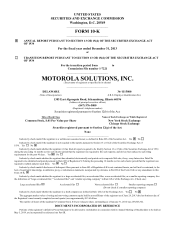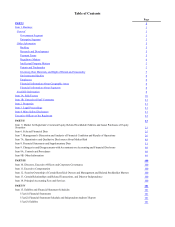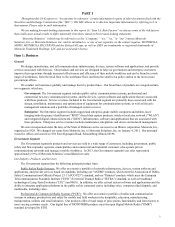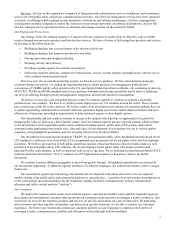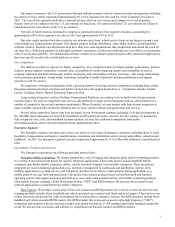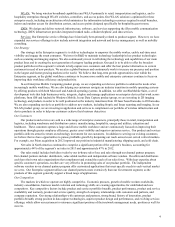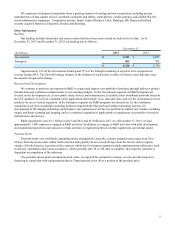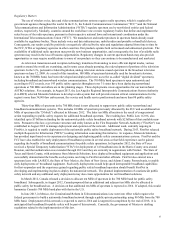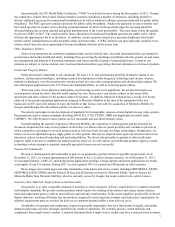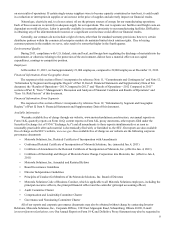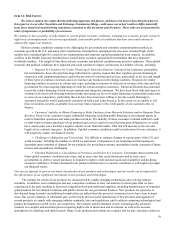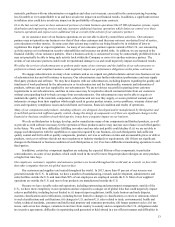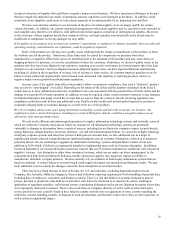Motorola 2013 Annual Report Download - page 8
Download and view the complete annual report
Please find page 8 of the 2013 Motorola annual report below. You can navigate through the pages in the report by either clicking on the pages listed below, or by using the keyword search tool below to find specific information within the annual report.6
Regulatory Matters
The use of wireless voice, data and video communications systems requires radio spectrum, which is regulated by
government agencies throughout the world. In the U.S., the Federal Communications Commission (“FCC”) and the National
Telecommunications and Information Administration (“NTIA”) regulate spectrum use by non-federal entities and federal
entities, respectively. Similarly, countries around the world have one or more regulatory bodies that define and implement the
rules for use of the radio spectrum, pursuant to their respective national laws and international coordination under the
International Telecommunications Union (“ITU”). We manufacture and market products in spectrum bands already made
available by regulatory bodies. These include voice and data infrastructure, mobile radios and portable or hand held devices.
Consequently, our results could be positively or negatively affected by the rules and regulations adopted from time to time by
the FCC, NTIA or regulatory agencies in other countries. Our products operate both on licensed and unlicensed spectrum. The
availability of additional radio spectrum may provide new business opportunities, and consequently, the loss of available radio
spectrum may result in the loss of business opportunities. Regulatory changes in current spectrum bands may also provide
opportunities or may require modifications to some of our products so they can continue to be manufactured and marketed.
As television transmission and reception technology transitions from analog to more efficient digital modes, various
countries around the world are examining, and in some cases already pursuing, the redevelopment of portions of the television
spectrum. In the U.S., pursuant to federal legislation, analog television stations ceased operation in the broadcast television
spectrum on June 12, 2009. As a result of this transition, 108 MHz of spectrum historically used for broadcast television,
known as the 700MHz band, has been redeveloped and deployed for new uses (the so-called “digital dividend” spectrum),
including broadband and narrowband wireless communications. The 700 MHz band spectrum is open nationwide and
according to FCC records, over 193 public safety agencies throughout over 31 states have been deploying narrowband
operations at 700 MHz and others are in the planning stages. These deployments create opportunities for our narrowband
ASTRO solutions. For example, in August 2013, the Los Angeles Regional Interoperable Communications System Authority
(LA-RICS) selected Motorola Solutions to develop a radio system that will provide mission critical communications for the
region’s more than 34,000 law enforcement, fire service and health service professionals and more than 80 public safety
agencies.
Thirty-four MHz of spectrum in the 700 MHz band is now allocated to support new public safety narrowband and
broadband communications systems. This includes 24 MHz of spectrum previously allocated by the FCC and an additional ten
MHz of spectrum (the “D block”) allocated in February 2012. The latter ten MHz allocation is the result of congressional
action responding to public safety requests for additional broadband spectrum. The resulting law, Public Law 112-96, also
identified up to $7 billion in funding for the nationwide public safety broadband network with $2 billion of that available near-
term. Pursuant to this law, a governance structure and entity known as the First Responder Network Authority ("FirstNet") was
established in August 2012 to manage deployment and operation of the network. Additional work, currently ongoing in
FirstNet, is required to enable deployment of the nationwide public safety broadband network. During 2013, FirstNet released
multiple Requests for Information ("RFI’s") seeking information concerning this initiative. In response, Motorola Solutions
has provided input based on its experience in designing and deploying public safety communications systems. FirstNet and the
FCC have also enabled the early deployment of broadband systems in several areas so that field experience can be gained
regarding the benefits of broadband communications for public safety operations. In September 2012, the State of Texas
received a Special Temporary Authorization ("STA") for deployment of 14 broadband sites in the Harris County area around
Houston, and that authorization was extended through 2013 and they are currently in negotiations with Firstnet. The State of
Texas and Harris County, with assistance from Motorola Solutions, have deployed broadband equipment and applications and
successfully demonstrated the benefits such systems can bring to FirstNet and other officials. FirstNet also entered into a
spectrum lease with LA-RICS, the State of New Mexico, the State of New Jersey, and Adams County, Pennsylvania, to enable
early deployments of broadband equipment. Such early deployments would help speed interoperable broadband capabilities
for first-responders and the experience gained regarding public safety broadband operation should benefit FirstNet in
developing and implementing its plan to deploy the nationwide network. The planned implementation of a nationwide public
safety network and any additional early deployments may also create opportunities for our broadband solutions.
In March 2012, Canada released a decision to allocate ten MHz of spectrum in the 700 MHz band for public safety
broadband. Subsequently, in August 2012, Canada proposed that an additional and adjacent ten MHz also be allocated to
public safety for broadband use. A decision on that additional ten MHz of spectrum is expected in 2014. If adopted, this would
harmonize Canada's 700 MHz band plan with that in the U.S.
In June 2013, in Mexico, the Constitutional Reform in Telecommunications Law went into effect which requires the
federal government to build a nationwide broadband network through a public-private partnership, using 90 MHz from the 700
MHz band. Deployment of this network is expected to start in 2014 and is targeted for completion by the end of 2018. It is
anticipated that broadband for public safety will be part of this network. Currently, the government of Mexico is drafting
regulations related to the implementation of this law.

